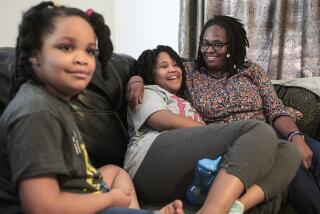CDC documents sickle cell disease risks
- Share via
African American children with sickle cell disease are at high risk of intellectual disabilities, hearing and vision deficits and frequent severe headaches, federal researchers said Tuesday.
Children with the inherited disease are at least four times as likely as similar children without it to have fair or poor health status, twice as likely to have recently visited a mental health professional and more likely to have received special educational services, according to a new study from the Centers for Disease Control and Prevention published in the American Journal of Preventive Medicine.
The results are not surprising to physicians treating the problem in children, but they do document what many had suspected, said Dr. Thomas D. Coates of the Center for Cancer and Blood Diseases at Childrens Hospital Los Angeles, who was not involved in the study.
The major significance of the report, he said, is that it marks a strong beginning to a new effort by the CDC “to address the problems of these patients. The whole area of sickle cell disease has been grossly neglected by CDC.”
The agency “is now fully engaged in trying to rectify this problem,” he said.
Sickle cell disease, which affects about one in every 350 black children, is a genetic disorder that causes red blood cells to assume a sickle shape under stress, clogging blood vessels and producing episodes of excruciating pain, called crises.
Two-thirds of patients have some type of blood vessel problem in the brain by the time they are 20, and 15% have severe strokes.
The only effective medication is hydroxyurea, which reduces crises by 50% and mortality by 40%. But most adults are not treated, Coates said. As a result, the median age of death for sickle cell patients is now 39, down from 42 in 1995.
In the new study, epidemiologist Sheree L. Boulet of the CDC and her colleagues used data from a national survey to identify 192 black children with sickle cell disease and 19,335 healthy black children.
The team found that children with the disorder were seven times more likely to suffer anemia -- the defining condition of the disease -- 50% more likely to suffer hay fever, 80% more likely to have food allergies, 120% more likely to have frequent diarrhea, 150% more likely to have headaches and migraines, 160% more likely to have hearing problems, and 230% more likely to have some intellectual disability.
Their parents reported that they had more difficulties getting medical appointments when crises happened and waited too long in doctor’s offices.
Boulet noted that the study found an incidence of about one in 100, suggesting that at least some of the parents who said their children had sickle cell anemia were incorrect, and that their children actually had sickle cell trait -- a more common, less severe condition in which the child carries only one copy of the sickle gene.
“What we are reporting is probably an under-representation of the true impact,” she said.






